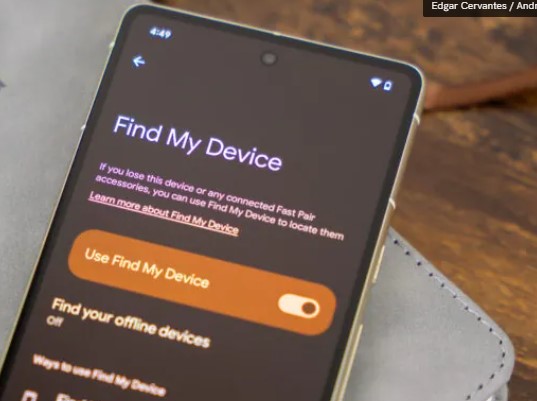1.Google upgrades
Google has announced a major update to its Find My Device function that incorporates biometric security to improve customer safety and experience. Since cellphones have become indispensable tools for exchange of information, communication, and the storing of personal data in the age of digital technology, this update addresses the growing demand for strong security measures. By enabling customers to access the location of their device via biometric verification, such facial recognition or fingerprint identification, Google the goal to give consumers a quicker and safer way to find missing or stolen apparatus.
2. Biometric Security: Protecting Personal Data
As technology for mobile devices develops, so are the risks that accompany it. Protecting personal data is important, as seen by the increase in smartphone crime and the possibility of hacking. Passwords and PINs are two examples of traditional device security techniques that have occasionally shown themselves to be less successful. They are not as trustworthy for protecting private data because they can be overlooked, calculated, or circumvented.
The solution provided by biometric security is more efficient. Biometric authentication adds a layer of security that is much more difficult to break by utilizing unique bodily traits like fingerprints or facial features. In the context of device monitoring, this is particularly crucial because illegal access to location data may result in privacy infringements or other illegal activities.
3.Upgrade Features: Biometric Authentication
Several significant improvements that improve security and usability are brought about by the incorporation of biometric security into Find My Device:
a. Authentication via biometrics
Users can now employ biometric techniques to verify their identity according to the latest update. This implies that users can access their device’s location by using their fingerprint or facial recognition instead of a password or PIN. This function speeds up the process of locating a misplaced device in addition to being convenient.
2. Increased Specificity in Location
Tracking the location of missing devices is now more accurate thanks to the updated Find My Device function. This is especially helpful in urban settings where dense constructions or towering buildings may block GPS signals. Improved algorithms make it easier to discover the device and guarantee that users can find their gadgets fast.
3. An attractive user interface
For a smooth experience, Find My Device’s user interface has been enhanced. Users can easily explore the app and obtain the services they require thanks to its intuitive structure. Users can set up biometric authentication and use the location tracking feature with ease thanks to clear instructions.
4. Strengthened Security Measures
To safeguard user data, Google has added new security measures in along with biometric authentication. In order to guarantee that only authorized users can access their device’s location data, this incorporates end-to-end encryption. To ensure the integrity of user privacy, these steps are essential.
5. Support for Multiple Devices
Support for numerous devices with a single account is another feature of Google’s update. With biometric authentication, users can now control the location settings on all of their devices, including wearables, tablets, and smartphones. This feature makes it simpler to keep track of numerous devices without having to worry about memorizing unique passwords for each one.
6. Alerts and Notifications
Notification capabilities that notify users when their device is located or relocated from its last known position will also be included in the upgraded Find My Device. This proactive strategy improves user security and awareness, enabling prompt action in the event that a device is stolen or misplaced.
4. Applying Biometric Protection
The procedure of configuring biometric security for Find My Device is simple. Here’s a detailed tutorial on turning on this feature:
Step 1 .First, go to Device Settings.
Navigate to your Android device’s settings menu. Usually, you can find this by tapping the gear symbol in the notification shade or by looking in the app drawer.
Step 2: Open the Security Configuration
Locate and tap the “Security” option by scrolling down. All of your device’s security settings are located in this section.
Step 3: Turn on biometric verification
Look for the “Face Recognition” or “Fingerprint” biometric authentication choices. If you haven’t already, register your biometric data by following the on-screen directions.
Step 5: Use your Google account to log in.
Launch the Find My Device app, then log in using your Google credentials. To access your device’s location and settings, you must complete this step.
Step 6: Turn on biometric authentication
The app will ask you to enable biometric login after you’ve signed in. Verify this choice to make the feature active. From now on, you can use your biometric authentication method to access the app.
5. The effects for Users
For users, the addition of biometric security to Find My Device has important ramifications.
1. Improved User Experience
The user experience is greatly enhanced by the biometric login feature. Without having to deal with the inconvenience of remembering passwords, users may easily access the location of their device. This effectiveness is particularly helpful in stressful circumstances, like losing a gadget.
2. Enhanced Privacy and Security
Users can feel safer knowing that their location data is safeguarded using biometric security. This is particularly important for protecting sensitive data from unwanted access. Because they are the only ones with access, users are less likely to be concerned about their information being compromised.
3. Technology-Assisted Empowerment
By giving consumers sophisticated capabilities to control their devices, biometric security empowers users. Users can take proactive measures to protect their personal data and enhance their digital security procedures as they grow more accustomed to these technologies.
4. Increased Biometric Technology Adoption
Google’s decision to incorporate biometric authentication into Find My Device might serve as a catalyst for other tech firms to follow suit. The need for these functionalities will probably grow across a range of platforms and apps as users grow used to using biometrics for security.
6. Resolving Privacy Issues
Even though biometric authentication has many benefits, potential privacy issues must be addressed. Concerns around the storage and usage of their biometric data are common among users.
1. Encryption and Data Storage
Google uses cutting-edge encryption techniques to safeguard biometric information. This implies that without the proper decryption keys, data would be illegible even if it were intercepted. In order to reduce the possibility of exposure through online servers, biometric data is frequently kept locally on the device.
2. Data Control by the User
Users are in charge of their biometric information. If individuals feel uncomfortable, they can choose to erase their stored biometric data or disable biometric authentication at any moment.
3. Conforming to Rules
In order to protect user privacy, Google complies with data protection laws and guidelines. Google’s dedication to user privacy and data security is reaffirmed by its adherence to regulations like the General Data Protection Regulation (GDPR).
4. Constant Improvements in Security
To handle new threats and weaknesses, Google modifies its security procedures on a regular basis. Because security measures are regularly updated and improved, users may feel secure knowing that their data is safe.
7. Comparing with old Security Techniques
Find My Device’s incorporation of biometric security signifies a departure from conventional security techniques. The following contrasts biometric authentication with traditional techniques:
1. Biometric Information versus Passwords
Tradiontally passwords are readily guessed, forgotten, or even stolen. Biometric information, on the other hand, is specific to each person and cannot be copied. Because of this, biometric authentication is a safer choice.
2. Convenience for Users
When using a password, the user must manually remember and enter it, which can be time-consuming and inconvenient. Users may access their smartphone with just a touch or glance thanks to biometric authentication, which offers a quicker and more practical option.
3. Opposition to Unauthorized Entry
Biometric characteristics are intrinsically linked to the person, whereas passwords can be exchanged or compromised. This makes it a safer choice for protecting personal data because it drastically lowers the possibility of unwanted access.
8. Biometric Security’s Future
The use of biometric security in programs such as Find My Device is only the first step. We may anticipate seeing much more advanced biometric solutions across a range of industries as technology develops.
1. Authentication using many factors
Multi-factor authentication techniques may be included into biometric security in the future, fusing biometrics with additional security measures. This multi-layered strategy improves security by making it harder for unauthorized users to get in.
2. Increased Use of Biometric Technologies
In addition to device tracking, biometric technology may find use in smart home appliances, banking, and healthcare. Biometrics’ adaptability offers prospects for enhancing security in a variety of sectors.
3. Regular Verification
Continuous authentication, in which the device continuously confirms the user’s identification using behavioral biometrics (such as typing habits and gait studies), may be incorporated into future biometric systems. A smooth and extremely safe user experience would result from this.
4. Artificial Intelligence Integration
Enhancing biometric security may be greatly aided by artificial intelligence (AI). More efficient biometric data analysis by AI systems could increase recognition precision and lower false positives.
9. In conclusion
To sum up, Google’s biometric security update for Find My Device is a major breakthrough in mobile security. This update not only enhances the user experience but also responds to the increasing demand for improved security against illegal access and device theft. Google shows its dedication to user safety and privacy in an increasingly digital environment by using biometric authentication.
Users expect a more effective and safe method of device management when they adopt this new functionality. All things considered, Find My Device’s incorporation of biometric security shows a proactive attitude to protecting private data in the rapidly evolving technological environment of today.
Also Read: Kashmir held India’s first local election after 2019 Special status.




